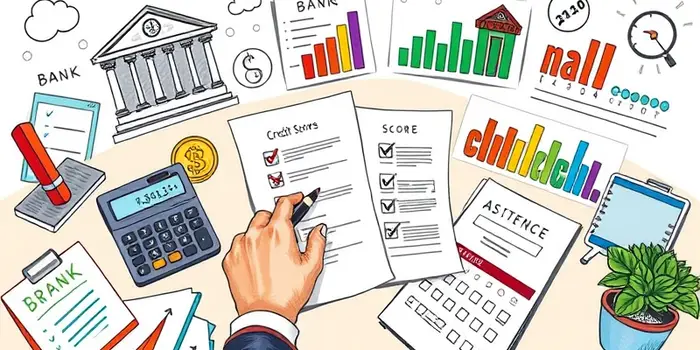
Taking out a personal loan can be transformative—whether you’re consolidating high-interest debt, financing a home renovation, or covering unexpected medical bills. However, without a clear roadmap, borrowers often find themselves facing unforeseen fees, soaring interest rates, or loan terms that strain their budgets. This comprehensive checklist will guide you step by step, offering actionable advice, data-driven insights, and motivational strategies to help you borrow with confidence and purpose in 2025.
At its core, a personal loan is a fixed-sum, unsecured personal loan that disperses a lump-sum payment upfront, to be repaid in equal installments over a predetermined term. Unsecured loans do not require collateral, while secured personal loans ask for an asset—such as a savings account, vehicle title, or certificate of deposit—to mitigate risk for the lender.
Choosing between a secured or unsecured option affects not only the APR you qualify for but also your financial risk. Secured loans can deliver lower rates, sometimes under 7%, yet they carry the hazard of asset forfeiture if you default. Unsecured loans offer greater peace of mind but often come with higher APRs to offset lender risk.
Unlike revolving credit lines, such as credit cards, most personal loans have a set repayment schedule. This predictability can simplify budgeting, giving you a clear end date when the debt will be retired. Knowing when you’ll be debt-free can be a powerful motivator and a key factor in any borrowing decision.
Before you even begin exploring loan options, take stock of your current financial standing. Your credit score is the single most influential factor impacting your interest rate. Borrowers with scores above 720 often access the most competitive APRs—sometimes as low as 5.99%. If your score lingers closer to 600, you may still qualify, but expect rates to climb.
To improve your credit profile, start by paying down existing credit card balances, setting up payment reminders, and disputing any inaccuracies you spot when you pull your credit report. Small, consistent actions—like reducing your utilization ratio below 30%—can translate into tangible score gains over a few months.
Your debt-to-income ratio (DTI) offers lenders a clear snapshot of how much of your monthly income goes toward debt obligations. Aim for a debt-to-income (DTI) ratio below 50%. If necessary, pause new borrowing and focus on chipping away at balances to improve your DTI before applying for a substantial loan.
Employment stability also carries weight. Lenders scrutinize your work history to ensure you have the means to fulfill repayment. Maintain consistent employment and be prepared to supply recent pay stubs, W-2s, or self-employment tax returns as proof of income reliability.
With your financial foundation in place, it’s time to compare offers from traditional banks, credit unions, and online lenders to get a sense of market rates. Many institutions offer pre-qualification processes that use a soft credit inquiry, preserving your credit score while providing personalized APR estimates.
Soft pulls do not impact your score, so feel free to pre-qualify with multiple institutions. This approach gives you the leverage to negotiate and helps you spot outliers—particularly lenders quoting sky-high APRs that should set off alarm bells.
Don’t overlook local credit unions. Often, they cater to members with fair credit and provide more flexible lending criteria. An unexpected credit union offer can undercut big banks and online lenders, saving you thousands in interest over your loan term.
To select the best partner for your personal loan, understand how APR ranges and requirements differ across lender types. The table below offers a snapshot of typical rates in 2025 and key considerations when evaluating each option.
Bank loans can be ideal if you maintain a high credit score and an active checking or savings account—some banks even reward loyal customers with discounted APRs. Credit unions, meanwhile, are community-focused and often cap rates at 18%, making them a top choice for value seekers.
Online lenders excel in speed and convenience. Many can deposit funds within one business day of approval, though their wide APR range means borrowers must shop diligently to avoid predatory offers. Always confirm whether origination fees, late fees, or prepayment penalties apply.
Gathering paperwork in advance will streamline your application and reduce stress when time is of the essence. Assemble these items before you submit any loan requests:
Having a comprehensive file folder—physical or digital—ensures you can respond quickly to lender requests and keeps the approval timeline moving smoothly.
When you’re ready to apply, anchor your decision-making in strategies that optimize affordability and flexibility:
Overborrowing or stretching payments over longer terms may lower your monthly obligation but often inflate the total amount you repay. Strike a balance that preserves your cash flow without sacrificing cost-efficiency.
If you face challenges qualifying, consider these tactics to strengthen your application:
Patience can pay off: waiting six to twelve months while you address financial weak spots can translate into hundreds or even thousands of dollars saved in interest over the life of the loan.
Before you accept a loan offer, perform a final review. Confirm that the APR, repayment term, monthly payment, and fees align with your expectations. Avoid surprises by seeking clarity on origination fees, prepayment penalties, and late-payment charges.
Steer clear of common pitfalls such as skipping a credit report review, submitting simultaneous hard inquiries, focusing solely on the monthly payment without calculating the total repayable amount, and ignoring prepayment options that could save you from additional interest.
Borrowing responsibly isn’t about avoiding loans altogether; it’s about mastering the process to serve your financial objectives. By following this detailed checklist, you’ll be equipped to assess your readiness, compare competitive offers, assemble the right documentation, and apply only borrow what you need with confidence. The path to a successful personal loan starts with preparation—it ends with the freedom of fulfilling your goals without regret.
Embrace these principles, adjust as your circumstances evolve, and revisit this guide whenever you consider new borrowing. With diligence, discipline, and the strategies outlined above, you can navigate the personal loan landscape in 2025 and beyond with clarity, resilience, and financial empowerment.
References













